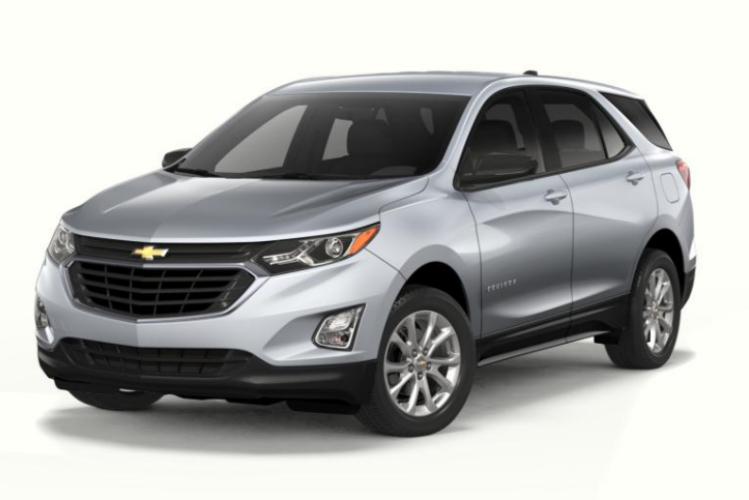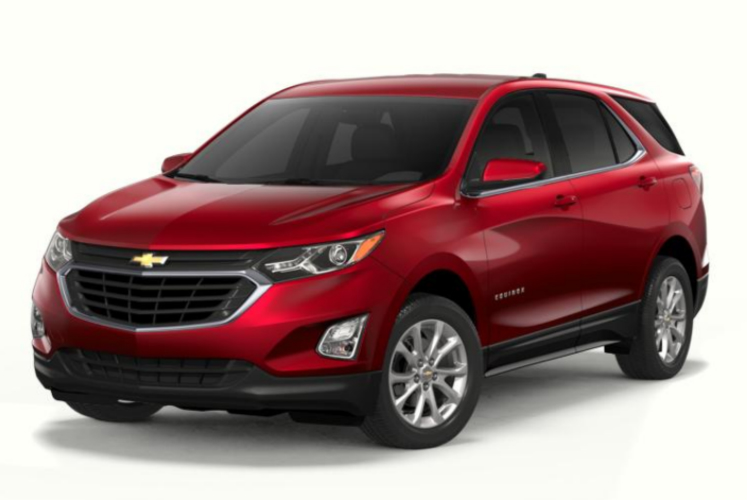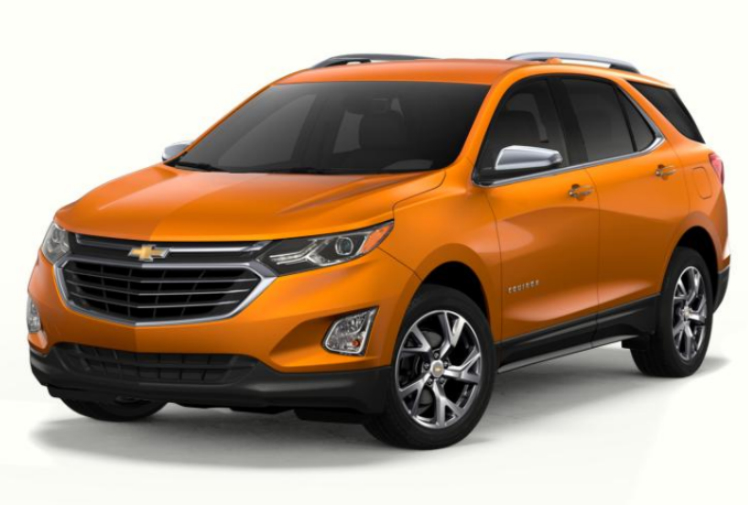The Equinox compact crossover is Chevrolet’s second-best-selling vehicle, following the Silverado pickup truck. For the 2018 model year, Chevy redesigned the Equinox’s exterior and interior, changed the styling, increased safety features, and added a turbodiesel engine option.
As we said in our first drive review when the new Equinox was first introduced earlier this year, the updates and upgrades are welcome and may help it compete in the very hot small crossover segment. The Honda CR-V, Toyota RAV4, Nissan Rogue, and Ford Escape all sold in higher numbers than the Equinox in 2016, so the new models could boost sales.
The 2018 Chevrolet Equinox model lineup includes combinations of four trim levels, three engines, and two drive wheel variations. You can mix and match the three elements to some extent, but only three of the four trims are available with all-wheel drive (AWD) and two trim levels are restricted to a single engine choice. See the Equinox trim breakdowns below for the details.
What’s new for 2018
The Equinox redesign pared about 400 pounds from the previous generation and borrows styling cues from other Chevys such as the Cruze, Volt, and Malibu. New safety options include Surround Vision, Low-speed Forward Automatic Braking, and a Safety Alert Seat. Also, the rear seats now fold flat for easier loading and more capacious cargo room.
The new 1.6-liter turbodiesel engine is the first offered in a compact crossover in the U.S. A 252-horsepower gas-powered 2.0-liter turbo introduced for the Equinox and available only with the LT and Premier trims is paired with a new nine-speed automatic transmission.
Engines and transmissions
A 1.5-liter turbocharged four-cylinder DOHC engine with Continuously Variable Valve Timing (CVVT) is standard equipment for all trim levels and is the only engine offered for the L and LS trims. The 1.5-liter motor has direct injection and stop-start technology, and is paired with a six-speed automatic transmission. The 1.5-liter turbo engine makes 170 hp at 5,600 rpm and 203 pound-feet of torque at 2,000 to 4,000 rpm, a relatively wide band for maximum power. With standard front-wheel drive (FWD), the 1.5-liter engine gets 26 miles per gallon in city driving and 32 mpg on the highway. All-wheel drive exacts a 2-mpg toll, for 24 mpg in the city and 30 mpg driving on the highway.
Chevy’s 2.0-liter turbocharged four-cylinder DOHC engine is one of two upgrade engine choices for the Equinox LT and Premier trims. The 2.0-liter motor cranks out 252 hp at 5,500 rpm and 260 lb-ft at 2,500-4,500 rpm. This engine also has CVVT, direct fuel injection, and stop-start technology. Paired with a new nine-speed automatic transmission, the 2.0-liter turbo is rated at 22 mpg in the city and 29 mpg on the highway for FWD models and 22 mpg city and 28 mpg highway fuel for AWD models.
The 1.6-liter turbodiesel upgrade option is a DOHC four-cylinder engine with stop-start technology that’s also available only with LT and Premium trims. The diesel upgrade is the Equinox mileage champ, returning 32 mpg in the city and 40 mpg on the highway for FWD models and 31 mpg city and 37 mpg highway performance with AWD. The 1.6-liter turbodiesel is rated at 137 hp at 3,750 rpm and 240 lb-ft at 2,000 rpm.
Tech features
There is no shortage of tech with the Equinox. All models include the MyChevrolet mobile app to remotely stop and start the engine, lock and unlock the doors, view vehicle diagnostics, and more. Vehicle connectivity with the MyLink app lets you handle calls, play music, and more using your compatible smartphone and the dashboard audio system and display.
Standard equipment with the Equinox includes the StabiliTrak electronic stability control system, LED daytime running lights, OnStar, rearview camera, teen driver settings, and tire pressure monitoring. The Driver Confidence and Convenience Package — available on the LT trim and standard with Premier models — includes Rear Park Assist, Rear Cross Traffic Alert, and Lane Change Alert with Side Blind Zone Alert.
The Driver Confidence and Convenience Package II available only with the Premier trim adds Safety Alert Seat, Forward Collision Alert, Low-Speed Forward Automatic Breaking with Following Distance Indicator, Lane Keep Assist with Lane Departure Warning, Intellibeam automatic high beams, and Surround Vision. So if you want all available safety and driver assist features with the Equinox, you’ll need the upgrade package even with the highest trim model.
How to choose a 2018 Chevy Equinox
If you’re thinking about an buying an Equinox but don’t care about AWD or an engine upgrade, your choice among the trim levels is fairly simple. Decide how much you want to spend on comfort, convenience, driver assistance, and luxury features and make your pick. All four trim levels, the L, LS, LT, and Premier, are available with front-wheel drive and the base 1.5-liter turbocharged engine and six-speed automatic.
If you want AWD, you’ll have to choose between the LS, LT, and Premier trims — the L trim has FWD only. If you want the more powerful 2.0-liter turbocharged engine or the economical diesel, the LS trim drops out of the picture, leaving your choice between the Equinox LT and Premier trims.
2018 Equinox L
The least expensive Equinox L, starting at $24,575, is no feature slouch. The L’s feature list serves as the base on which other trims build. The L trim’s highlights include remote keyless entry, push-button start/stop, Chevrolet MyLink Radio with a 7-inch color touchscreen, and a rear vision camera.
Other standard features include a USB port, a 3.5mm auxiliary audio input jack, and a 12V power outlet. Teen driver technology is standard on all Equinox trims, so you can configure vehicle features and get reports on driving behaviors.
The L trim has carpeted front floor mats, active noise cancellation, and a built-in Wi-Fi hot spot (data plan required). Power windows, power door locks, an electronic parking brake, cruise control, LED daytime running lamps, halogen composite headlamps, and outside heated power-adjustable side mirrors are also included. Active aero shutters behind the front grille cut air resistance for all trims.
2018 Equinox LS
The upgrade to the LS trim, starting price $26,505, includes a compact spare tire, carpeted rear floor mats, and a compass. The LS model unlocks the choice for all-wheel drive and for option packages you can’t get with the L trim.
2018 Equinox LT
You can configure the Equinox LT with AWD and either of the two engine upgrades, plus the LT has additional available convenience and safety feature options and packages. The LT’s $27,745 starting price also bumps up the standard feature list to include high-intensity discharge headlamps, a power adjustable driver seat with driver lumbar, heated power-adjustable manual-folding outside mirrors, second-row mechanical seat release levers, deep-tinted rear glass, and roof-mounted luggage carrier fittings.
2018 Equinox Premier
The Equinox Premier trim is the loaded version, with a $31,785 starting price for FWD with the 1.5L turbo engine. In addition to the LT features, the Premier trim standard equipment includes the new Driver Confidence Package with Rear Park Assist, Rear Cross-Traffic Alert, Lane Change Alert with Side Blind Zone Alert, and heated outside power adjustable mirrors with turn signal indicators.
Upgrading to the Premier model also adds dual-zone automatic climate control, an 8-inch color touchscreen display for the infotainment system, two USB charging ports plus two USB data ports, and two 120V power outlets.
Memory presets for the driver seat and outside mirrors. remote start, heated front seats, leather-wrapped steering wheel, a universal garage door opener, fog lamps, wireless charging, LED headlamp and tail lamps, and a hands-free power liftgate complete the Premier package.
The Premier trim does not include the full suite of available driver assist and passive safety features, nor does it include a sunroof or navigation system. If you want to load up an Equinox with those options and add AWD and one of the engine upgrades, you’ll quickly drive the list price over $40,000.
| Trim | 2018 Equinox L | 2018 Equinox LS | 2018 Equinox LT | 2018 Equinox Premier |
| Base price | $24,575 starting | $26,505 starting | $27,745 starting | $31,785 starting |
| Drive wheels | Front | Front | Front | Front |
| 4WD/AWD? | N/A | AWD optional | AWD optional | AWD optional |
| Base engine/Opt | 1.5L Turbo | 1.5L Turbo | 1.5L Turbo/2.0L Turbo/1.6L Turbo Diesel | 1.5L Turbo/2.0L Turbo/1.6L Turbo Diesel |
| Base horsepower | 170 hp at 5,600 RPM | 170 hp at 5,600 RPM | 170 hp at 5,600 RPM | 170 hp at 5,600 RPM |
| Base torque | 203 lb-ft at 2,000-4,000 RPM | 203 lb-ft at 2,000-4,000 RPM | 203 lb-ft at 2,000-4,000 RPM | 203 lb-ft at 2,000-4,000 RPM |
| Transmission | Six-speed automatic | Six-speed automatic | Six-speed automatic | Six-speed automatic |
| Fuel | Regular gas | Regular gas | Regular gas | Regular gas |
| Fuel capacity (gallons) | 14.9 gallons FWD | 14.9 gallons FWD/15.6 gallons AWD | 14.9 gallons FWD/15.6 gallons AWD | 14.9 gallons FWD/15.6 gallons AWD |
| Fuel economy | 26 city/32 highway FWD | 26 city/32 highway FWD//24 city/30 highway AWD | 26 city/32 highway FWD//24 city/30 highway AWD | 26 city/32 highway FWD//24 city/30 highway AWD |
| Base wheels | 17-inch aluminum | 17-inch aluminum | 17-inch aluminum | 18-inch aluminum |
| Body style | 4-door SUV | 4-door SUV | 4-door SUV | 4-door SUV |
| Passengers | 5 | 5 | 5 | 5 |
| 3rd-row seating | N/A | N/A | N/A | N/A |
| Storage behind 2nd-row seats | 29.9 cu ft | 29.9 cu ft | 29.9 cu ft | 29.9 cu ft |
| Storage behind 1sr row seats | 63.5 cu ft | 63.5 cu ft | 63.5 cu ft | 63.5 cu ft |
| Max Towing capacity | 3,500 pounds with 2.0L engine | 3,500 pounds with 2.0L engine | 3,500 pounds with 2.0L engine | 3,500 pounds with 2.0L engine |
| Seat upholstery | Cloth | Cloth | Premium Cloth | Leather |
Editors' Recommendations
- 2024 Chevrolet Equinox EV: price, release date, range, and more
- Could EVs charge wirelessly? Here’s what you need to know
- From dongles to diagnostics, here’s all you need to know about OBD/OBD II
- Apple Car: What you need to know about Project Titan
- Electric car buying guide: What you need to know before you buy








